Two New Ions: ASUS AT3N7A-I and ASRock Ion 330
by Anand Lal Shimpi on August 28, 2009 12:00 AM EST- Posted in
- Motherboards
Sidebar: ASRock Ion 330
Although today is all about ASUS’ entry into the Ion world with the AT3N7A-I, it’s also about picking your perfect Ion platform. I decided to round up the three Ion boards/systems currently on the market and compare them all as we evaluate the ASUS.
The Zotac Ion you already know about, we’ve covered it extensively and more recently looked at its latest PCB revision. The Ion platform you haven’t seen on AnandTech is ASRock’s Ion 330.
Unlike the ASUS and Zotac solutions, the ASRock Ion 330 is a complete system. For $379.99 you get a mini-ITX case, power supply, 2GB of memory, DVD drive and a 320GB hard drive - in addition to the ASRock Ion board. To give you an idea of scale I set the ASRock Ion 330 next to a standard 3.5” hard drive:
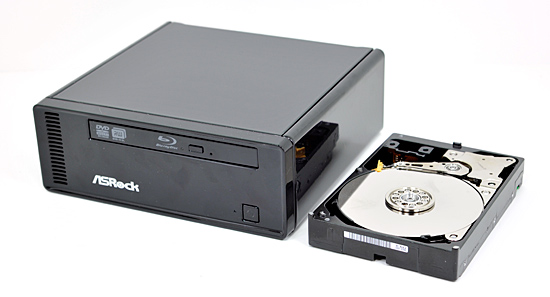
So, so sweet and small.
On the back of the ASRock Ion you get a healthy serving of 6 USB ports, VGA out, HDMI out, an Ethernet jack, three 1/8” audio jacks and optical audio out. There’s also a connector for the external 65W DC power supply. Despite this being 2009, there are no ports on the front of the chassis; it does keep things clean, but slightly inconvenient at the same time.
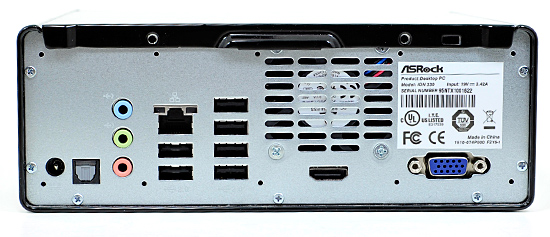
Inside there’s not much to see at first glance. Two screws hold the top cover on, removing them and sliding the cover back reveals the removable carrier that holds the slimline DVD drive and 2.5” HDD:
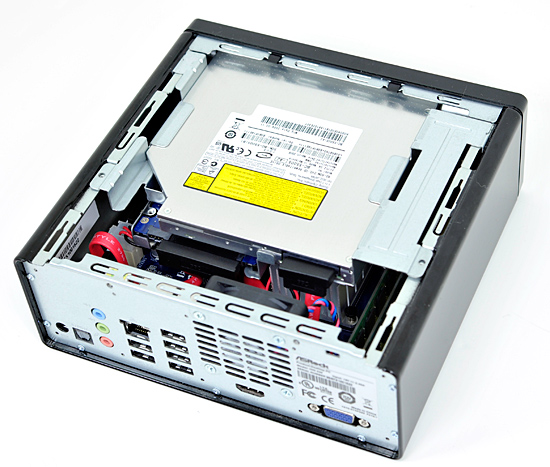
ASRock sent us the significantly more baller Ion 330-BD model, which forgoes the DVD drive for a slimline Blu-ray drive. The impact on price shouldn’t go unnoticed as the drive costs around $200 more than the standard DVD drive.
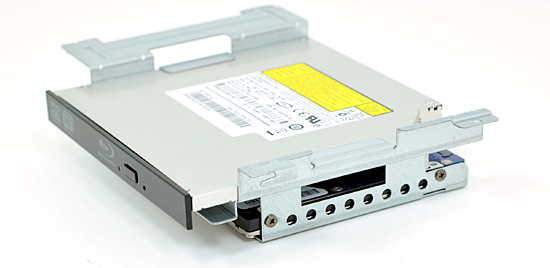
The slimline drive uses a mini-SATA power connector instead of standard SATA power. It’s supplied power somewhat crudely by a 4-pin 5V header on the motherboard that splits off and feeds both the optical drive and HDD.
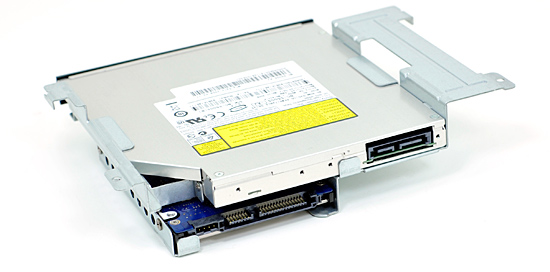
The hard drive is a standard 2.5” notebook drive. In this case it’s a 320GB Seagate Momentus 5400.6.
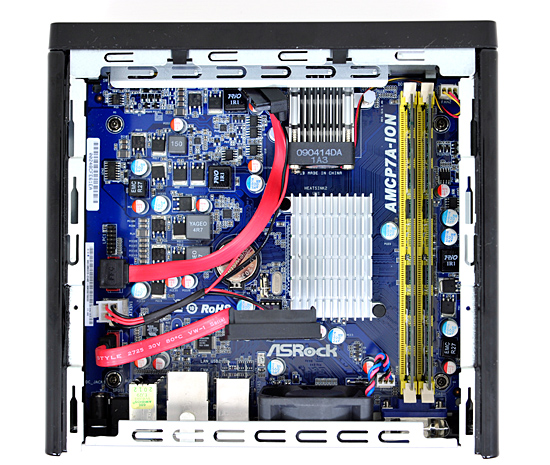
Below the drive carrier lies the motherboard itself and its two-fan cooling solution. A very small fan up front keeps the Atom processor cool. A larger fan in the back moves air around the rest of the chassis. The NVIDIA GPU doesn’t have a fan directly mounted to its heatsink and instead relies on the two fans to move heat off of its fins.
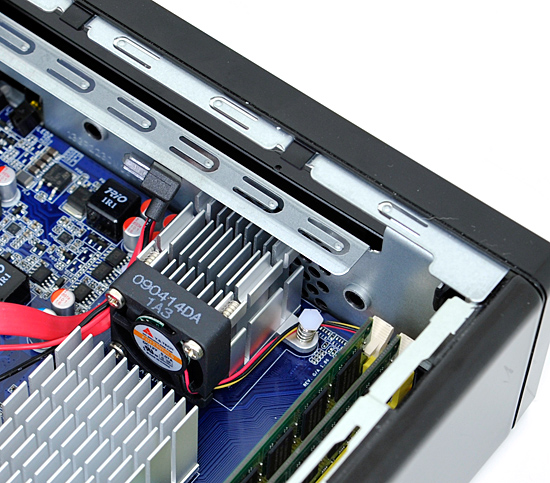
The smaller, and quieter CPU fan

The larger, and louder chassis fan
I hate to spoil the surprise, but the ASRock Ion 330 is built off of the same hardware as the ASUS and Zotac boards. You get a 1.6GHz dual-core Atom 330 combined with a NVIDIA GeForce 9300/9400M chipset. The result? Nearly identical performance.
The ASRock is nice from a convenience standpoint, all you do is buy the machine and load an OS on it. The major issues with it are a fan that isn’t silent (more on this later), and the fact that if you want to use an SSD in the machine you’re out $70 since it comes with a non-optional 2.5” HDD.










61 Comments
View All Comments
rudy - Friday, August 28, 2009 - link
ASUS is messed up in this respect the last a8n-e board I used had the same stupid issue a small fan that was loud and broke down easily on the south bridge. It must be a cost issue but it causes more problems then its worth. I replaced it with a passive heatsink rather then getting a free one from asus cause I knew the free replacement would not be much better.bh192012 - Friday, August 28, 2009 - link
Put the bluray drive all the way at the top, make the case 1 to 2 cm deeper and or higher and put a row of low rpm 60mm fans in the front. You could get two to three times the airflow and it would be quieter. Also, why have the restrictive punchouts in the back for the rear fan, seems you could open that up much more. Punch more holes all along the sides or in the blank area in the back.yuchai - Friday, August 28, 2009 - link
I agree with this. These smaller devices are meant to be placed on the desk and are pretty close for the user. I wouldn't mind having them at a bigger size if that's what it takes to bring the noise level down.Das Capitolin - Friday, August 28, 2009 - link
The hard drive beside the ASRock ION 330 is not what comes with the unit. It ships with a 320GB notebook drive, and not a 3.5" desktop drive.Anand Lal Shimpi - Friday, August 28, 2009 - link
The hard drive was just included to show the small size of the machine, I'll clarify in a caption :)Take care,
Anand
yehuda - Friday, August 28, 2009 - link
I don't think this was mentioned, but Asus has also introduced an Ion-based EeeBox, which is a complete system.http://www.asus.com/product.aspx?P_ID=wH1q2VTqyLXa...">http://www.asus.com/product.aspx?P_ID=wH1q2VTqyLXa...
Anand, you think you could request a sample?
elivebuy - Tuesday, December 8, 2009 - link
http://www.elivebuy.com">http://www.elivebuy.comAir jordan(1-24)shoes $33
UGG BOOT $50
Jewerly $20
Nike shox(R4,NZ,OZ,TL1,TL2,TL3) $35
Handbags(Coach lv fendi d&g) $35
Tshirts (Polo ,ed hardy,lacoste) $16
Jean(True Religion,ed hardy,coogi) $30
Sunglasses(Oakey,coach,gucci,Armaini) $16
New era cap $15
Bikini (Ed hardy,polo) $25
FREE sHIPPING
http://www.elivebuy.com">http://www.elivebuy.com
millerduck - Friday, August 28, 2009 - link
That unit looks sweet. I stumbled on it over the last two days and am planning a Windows Home Server based on it.Looks to be fanless, 330 w/ION, eSATA for additional storage, gigabit Ethernet. A perfect WHS "appliance" for my house.
MD
Anand Lal Shimpi - Friday, August 28, 2009 - link
Just requested it :) Waiting to hear back from ASUS on their plans for this thing in North America.Take care,
Anand
yehuda - Saturday, August 29, 2009 - link
Thanks, please keep us posted.